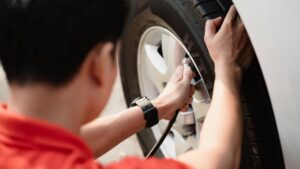Random Crashes And Spins Plagued The First Driverless Motor Race

It was a historic weekend for racing, and I’m not just talking about Jaguar’s win in Monaco at the Formula E on Saturday. Instead, the Autonomous Racing League broke barriers when it kicked off its first real-life competition at the Yas Marina circuit in Abu Dhabi. However, the barriers being broken were the ones bordering the circuit, as the event was plagued with random crashes and spins from the self-driving race cars.
Broadway Star Wendell Pierce Is a True Formula 1 Fan
The Autonomous Racing League (A2RL) was created in an attempt to reignite science and technology education in the United Arab Emirates and beyond, by showcasing just what technology might one day be capable of.
To do this, the A2RL kicked off with a grid filled with heavily-modified Dalara race cars, which bear a striking resemblance to the kinds of cars junior drivers race in Japan’s Super Formula series. However, instead of having space for a driver in the cockpit, the A2RL cars has an array of cameras, sensors and computers to drive the car.
A2RL RECAP
When all that computer power hit the track, things didn’t go super well. As the Verge explains:
The first race of the Abu Dhabi Autonomous Racing League (A2RL) took place on the Yas Marina Abu Dhabi Grand Prix Formula 1 track today, and I’m pleased to report that a race both began and ended. But the event was not without strife — far from it. During qualifying time trials, the driverless Dallara Super Formula racers outfitted with cameras and software seemed to struggle mightily to complete a full lap.
Over the course of that full lap, the onboard computers are expected to find the perfect racing line, monitor tire performance and even try to overtake one another. That, at times, proved too much for some of the cars, with them spinning wildly on the straights, turning randomly into barriers and crashing in spectacular style. As the Race adds:
There were a couple of incidents: on one occasion a car turned straight into the barriers at the inside of a corner; on another occasion one car rear-ended another.
After all that drama, you’d be forgiven for forgetting that teams had to set timed laps around the Yas Marina F1 circuit, with the fastest outfit being Polimove in with 2:00.653, reports the Race.
For comparison, the F1 lap record around the circuit is 1:26.103, while F2 cars can lap the track in 1:37.445. The closest driver-driven car around Yas Marina is the Gulf Radical Cup, which sees modified Radical racers compete around the track in lap times of around one minute 57 seconds.
Could you see this kind of racing take off? Photo: Waleed Zein/Anadolu (Getty Images)
The race itself then got underway, and was also hit with dramatic crashes and spins. As the Verge reports:
When it came time for the actual race, the lead racer, Polimove, spun out on the fourth of eight laps. The second car, Tum, passed it safely, but shortly after that, the event’s officials threw up a yellow flag. And since these are good AI drivers who obey the rules, the two behind Polimove stopped, unwilling to pass the spun-out yellow car. Racers aren’t supposed to pass each other during a caution lap, you see.
About an hour after the first lap of A2RL began, the AI racers completed their eight-lap race. If you must know, Tum won.
All in, it was certainly an interesting science experiment but maybe not the greatest racing spectacle of all time. But what do you think? Is motorsport the best way to train and trial autonomous driving systems, or is that better left to untrained drivers on the crowded streets of America, as Tesla seems to think.






